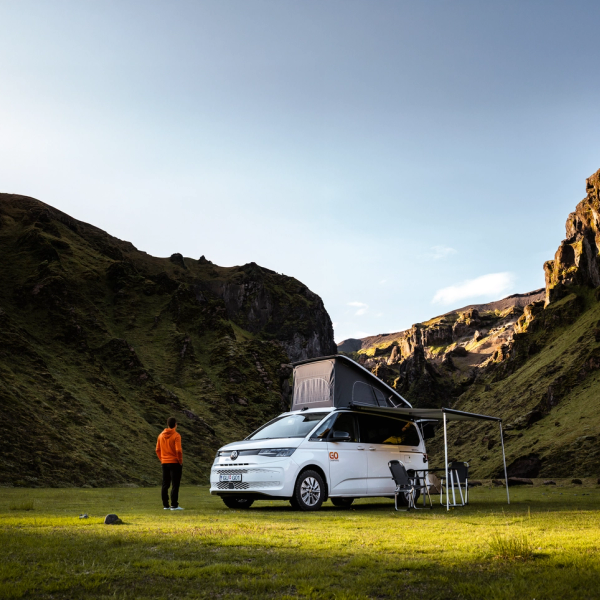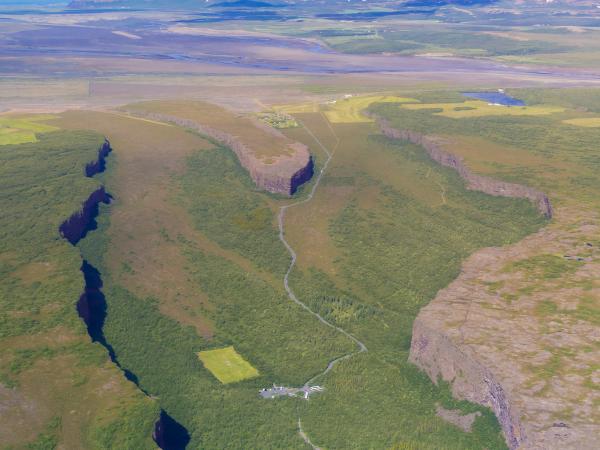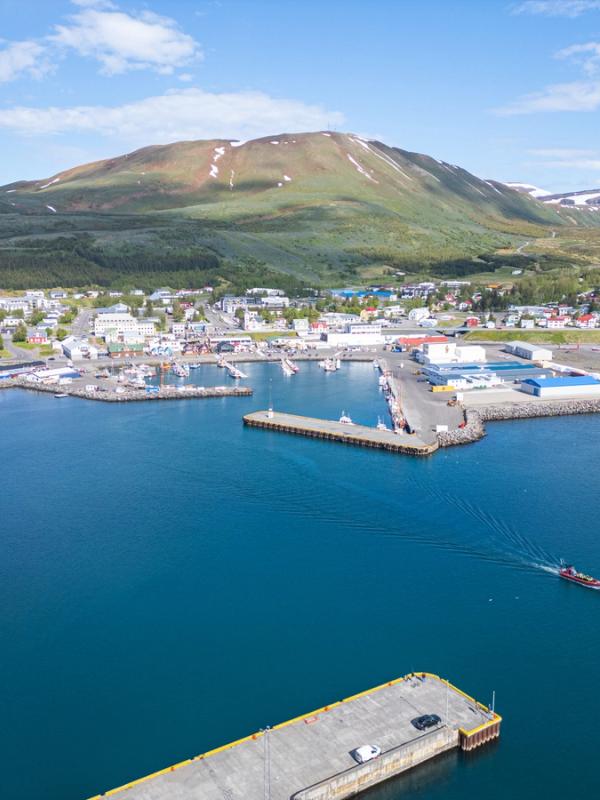
Húsavík: Complete Guide to the Whale Watching Capital of Iceland
Húsavík may be small, but step onto its harbor front and you’ll quickly see why it’s earned the nickname "Iceland’s whale capital". Out in Skjálfandi Bay, humpbacks breach against a backdrop of snow-streaked mountains while dolphins race the bows of oak boats. For a fishing town this size, the wildlife spectacle feels almost unreal.
This little town in the north has long now been a magnet for tourists; here’s our guide on what to see and do in Húsavík, the whale watching capital of Iceland.
Should I Visit Húsavík?
Yes, you should. If you’re circling the Ring Road, Húsavík is a stop that punches far above its weight. Come for the whales, stay for the hot pools and the charm of a proper fishing town that hasn’t lost its working edge.
Nestled along the Skjálfandi Bay, this town is one of the best places in the world to spot humpbacks, minke whales, and even the elusive blue whale. Beyond the boat tours, you’ll find the award-winning Húsavík Whale Museum, a picturesque harbor front area to stroll, and the soothing GeoSea sea baths with panoramic views of the bay and mountains.
There’s also a clutch of fantastic restaurants and cafés to enjoy, and several points of interest to check out if you’re at all a fan of the film Eurovision Song Contest: The Story of Fire Saga.
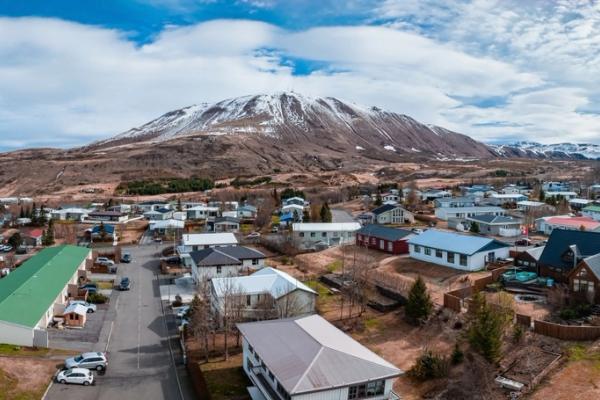
How to Get to Húsavík
It takes roughly 6 hours to get to Húsavík from Reykjavik, but it’s better visited as part of a larger trip around the ring road.
It’s a solid six-hour drive from Reykjavík if you push straight through, though in reality, the scenery makes it impossible not to stop. Expect to detour for waterfalls, fjords, or at least a gas-station hot dog or two. You’ll be following the Ring Road the entire way until after Akureyri, when you’ll turn north to reach Húsavík.
But for most, Húsavík will be one stop on a road trip around the country. For ring road travelers who are road tripping anticlockwise, it’ll fall just after some explorations around Lake Myvatn and the Diamond Circle. Heading clockwise, you’ll have just come through Akureyri, where it’s always recommended to spend some time.
When is the Best Time to Visit Húsavík?
Late May and September are sweet spots: long days, active whales, and far fewer tour buses clogging the harbor.
- Summer (June–August): The best time for whale watching, with long daylight hours and nearly guaranteed sightings. Expect the busiest crowds.
- Spring (April–May): Quieter, with increasing whale activity and milder weather. Ideal if you want to avoid peak season.
- Autumn (September–October): Northern lights begin to appear, while whale tours still run regularly until November.
- Winter (November–March): The town slows down, but GeoSea baths and the northern lights make it worth a visit if you don’t mind limited services.
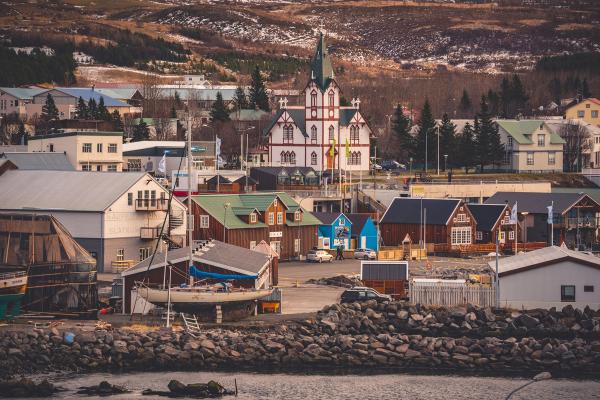
Why is Húsavík Such a Famous Whale-Watching Hub?
Because Skjálfandi Bay is one of the richest whale feeding grounds in Iceland.
Húsavík owes its reputation to the nutrient-dense waters of the bay, which attract everything from humpbacks and minke whales to playful dolphins and, occasionally, the mighty blue whale. Its shallow depths and sheltered setting mean whales are more likely to surface close to shore, creating some of the most reliable sightings in Iceland. This unique natural environment, combined with decades of local expertise, has made Húsavík the country’s undisputed whale-watching capital.

Best Things to Do in Húsavík
The town might be small, but there’s quite a lot to do nowadays in Húsavík, making it easy to spend a day here or even stay overnight.
1. Whale Watching in Skjálfandi Bay
We’ve already mentioned it several times, but Húsavík’s reputation as the whale watching capital is well earned. The deep, sheltered waters of Skjálfandi Bay are a feeding ground for up to 23 different species of whales and dolphins, and summer sightings have success rates hovering around 98%. Humpbacks are the stars of the show, often slapping their fins or breaching entirely out of the water, but you might also encounter minke whales, white-beaked dolphins, and occasionally the mighty blue whale, the largest animal on Earth.
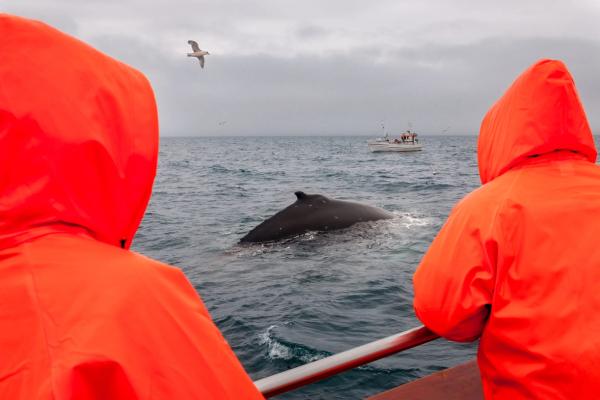
2. Visit the Húsavík Whale Museum
If you’ve just been out on the bay, the Whale Museum offers a fascinating deep dive into the world you’ve glimpsed. Spread across several floors of a repurposed warehouse, it houses skeletons of whales and dolphins, including an immense blue whale skeleton that gives you a sense of their staggering scale.
Exhibits explain whale biology, migration, and conservation, as well as the complex history of whaling in Iceland. The museum also touches on the cultural importance of these animals, both in local folklore and modern tourism. It’s well worth an hour or two, especially if the weather turns.

3. Soak in GeoSea Geothermal Baths
Yes, there’s a luxury hot spring in Húsavík as well. The GeoSea Geothermal Baths sit on the cliffs at the edge of town, commanding incredible views over the whole bay from the warm, infinity-edge pools. Unlike many Icelandic hot springs, GeoSea’s water is drawn from the sea itself, geothermally heated and rich in minerals said to be good for the skin. The result is a slightly salty soak that feels different from the fresh, silica-rich water of places like the Blue Lagoon.
From September until April, clear nights here might reward you with the northern lights dancing overhead, while the Midnight Sun in the summer months is always special in the north. There’s a small café and bar for drinks, but most visitors come simply to sink into the steaming water and let the views do the rest.
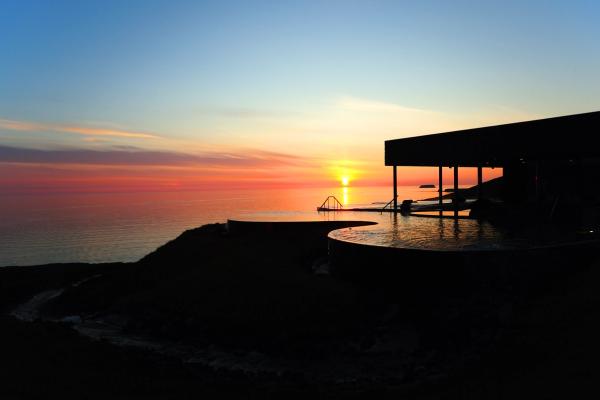
4. Visit the Húsavík Eurovision Exhibition
Húsavík isn’t only about whales. Since the release of Eurovision Song Contest: The Story of Fire Saga, starring Will Ferrell and Rachel McAdams, the town has become a quirky pilgrimage site for fans. The Húsavík Eurovision Exhibition showcases memorabilia from both the film and the wider Eurovision contest, making it a fun stop for anyone caught up in the music and movie magic. Afterwards, attached to the exhibition is the Jaja Ding Dong Café, where you can grab a bite to eat and a drink.
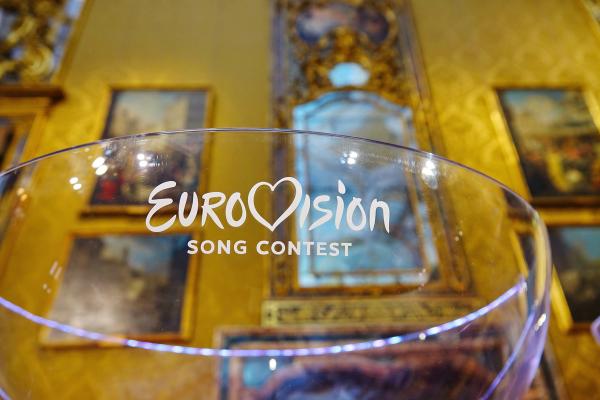
5. Wander Through Town
Húsavík’s working harbor is the town’s heartbeat. Fishing boats unload their catch alongside the whale watching vessels, and the air carries a mix of salt and diesel. The waterfront is lined with colorful wooden buildings housing cafés, tour operators, and souvenir shops. In summer, flower boxes spill with blooms, and the nearby hills glow with lupines. One of the town’s most striking landmarks is the Húsavík Church, a green-and-white wooden structure built in 1907 that remains a favorite photo stop. The streets behind the harbor are quiet, with houses painted in cheerful colors and gardens tucked behind low fences.
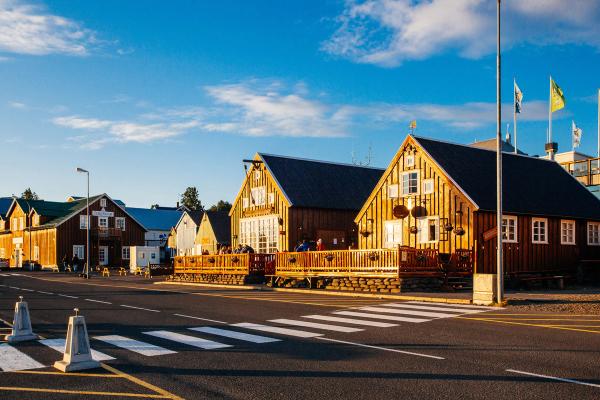
What Else Can I See Nearby?
Húsavík sits at one corner of the Diamond Circle, northern Iceland’s answer to the Golden Circle near Reykjavik. Travelers can also focus on individual highlights along the route for a deeper experience.
The Diamond Circle Route
While many visitors stop in Húsavík for a few hours, those who stay longer discover it’s an ideal base for exploring the Diamond Circle. Within a short drive you can reach Ásbyrgi Canyon, a horseshoe-shaped gorge steeped in folklore; Dettifoss, Europe’s second most powerful waterfall, thundering through a basalt canyon; and Lake Mývatn, with its steaming geothermal vents, pseudo craters, and birdlife.
Touring all three spots is possible in a day, although you’ll need an early start and expect to arrive back in Húsavík by dinner, if you’re staying overnight.
Lake Mývatn
Drive just 45 minutes south from Húsavík and you'll reach Lake Mývatn, a shallow lake born from a massive basaltic lava eruption 2,300 years ago. This geothermal playground is home to a solid number of geothermal sights in a smallish area: bubbling mud pots, steam vents, hot springs, and bizarre lava formations all create an atmosphere that feels more like another planet than Earth.
What's fascinating about Mývatn is how life thrives in this harsh environment. The lake supports over 115 bird species during the summer months, including rare duck varieties you won't find anywhere else in Iceland. After a day of exploring these alien landscapes, the Mývatn Nature Baths offer the perfect way to unwind. These mineral-rich waters stay at a comfortable 36-40°C year-round and see far fewer crowds than the Blue Lagoon.
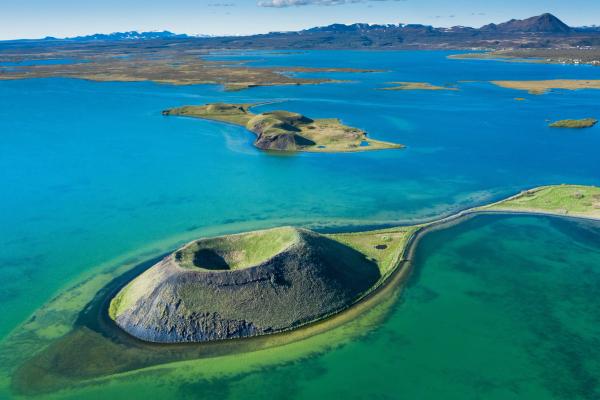
Ásbyrgi Canyon and Dettifoss waterfall
Head northeast from Húsavík and you'll discover the horseshoe-shaped Ásbyrgi Canyon, stretching 3.5 km long and 1 km wide with 100-meter cliffs towering above. Norse mythology claims Odin's eight-legged horse Sleipnir created this unusual formation when his hoof touched the ground. The canyon floor's peaceful woodland and well-marked hiking trails make for a perfect afternoon, regardless of how it formed – or you could spend a whole day here hiking the rim of the canyon itself.
Further south lies Europe's second most powerful waterfall, Dettifoss. This beast thunders down the Jökulsárgljúfur canyon, dropping 45 meters and spanning 100 meters wide while pumping an incredible 193 cubic meters of water per second. The east bank has more developed viewing platforms if you want easier access, but the west bank gives photographers those intimate, dramatic shots that make the rougher approach worthwhile.
Where to stay in Húsavík
Húsavík has accommodation options for pretty much every budget and travel style.
Aside from the town’s campsite, which was recently revamped, much to the delight of campers, Húsavík has a clutch of good hotels to choose from, and B&Bs in town as well as the surrounding countryside.
Fosshotel Húsavík is the obvious choice if you want to be right near the harbor action. For something with more character, guesthouses like Árból, Gamli Skólinn, and Skjálfandi Apartments give you that local feel.
If you're the outdoorsy type, Kaldbakskot has eighteen cottages with mountain views that are hard to beat. Budget travelers will find Húsavík Hostel does the job nicely.
The Best Campsites near Húsavík
If you want to stay outside the city with you campervan, these are the best options.
Camping 66.12 North
One of the coolest campsites in the country, this spot sits northeast of town at the tip of the peninsula. The owner curates an interesting museum inside one of the houses on his farm, which sits literally at the edge of the coast, with stunning views out over the ocean which lights up in the midnight sun or with the northern lights.
Heiðarbær Campsite
A bit south of Húsavík on Route 87, this is a popular spot with Icelandic families looking to set up their caravans and stay a while. Trees provide windbreaks across the campsite, there are shared kitchen facilities, but best of all, there’s also a restaurant and a swimming pool.
Ásbyrgi Campsite
A bit further away is the campsite in Ásbyrgi, run by Vatnajökull National Park. The site is incredible, sitting right next to the towering cliffs of the canyon, and is often quite protected from wind and bad weather.
Best places to eat and drink in town
Gamli Baukur Restaurant sits right by the harbor and serves up fresh seafood with views that'll make you forget about your meal for a moment. Naustið has built quite a reputation for its fish soup, while Salka Restaurant operates out of one of the town's oldest buildings.
After dinner, the Eurovision-inspired Jaja Ding Dong bar is worth a visit for the novelty alone, or you can sample local brews at Húsavík öl.
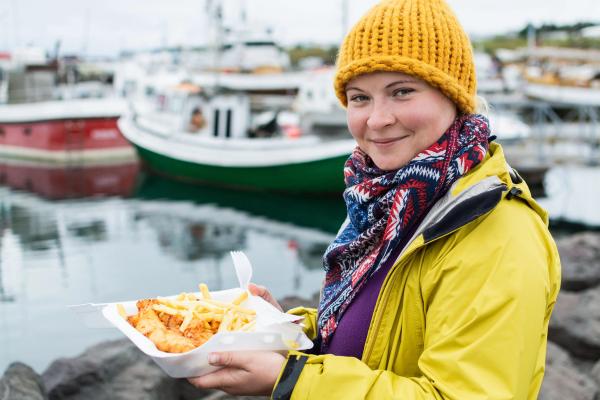
What’s the weather like in Húsavík?
For a town this far north, Húsavík is milder than you’d expect. Summer highs hover around 55°F, which feels warm when the sun never sets. Winters are cold but rarely brutal; enough to bring out the Northern Lights without freezing you solid. Temperatures hover between 23-32°F in January, perfect for Northern Lights hunting.
Rain isn't too much of a concern here. October tends to be the wettest month at 100mm, while May is the driest at just 35mm. In our opinion, spring offers some of the best visiting conditions: decent weather without the summer crowds.
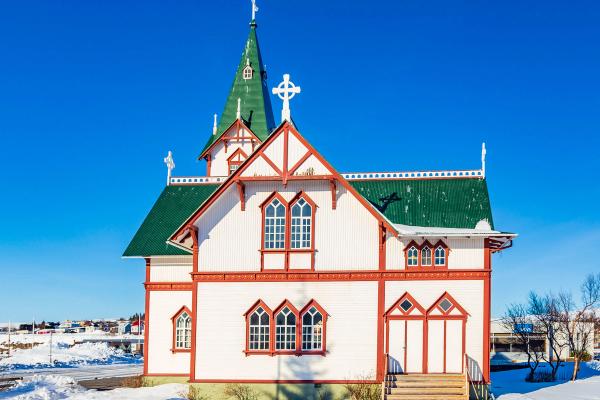
A Brief History of Húsavík
Long before whale watching made it famous, Húsavík was a quiet fishing settlement on the edge of Skjálfandi Bay. According to Icelandic sagas, one of the very first Norse explorers landed here in the 9th century, giving the town its name, which translates to “Bay of Houses.” Fishing sustained the community for centuries, and even today, the harbor buzzes with working boats alongside tour operators. This blend of seafaring heritage and modern tourism gives Húsavík a character all its own.
Húsavík Insider Tips
During the summer months, whale watching tours run in the evening as well. The late tours that run from 8 pm to 11 pm are magical if the weather is clear, as you’ll be sailing under the Midnight Sun.
Another good tip is to keep a lookout for tours that combine puffin viewing as well; Lundey Island off the coast is easily accessible via boat, and is rich with puffin life. An easy way to tick off two wildlife sightings in one outing.
Or, if you’d rather stay on land, head northeast to the Tjörnes Peninsula. The cliffs at Hringsbjarg are a reliable puffin spot, especially early in the morning (7–10 am) or late in the evening (after 9 pm), when the birds return from feeding at sea.
Adding Húsavík to your Iceland Itinerary
Húsavík is a town that, for many, captures the magic of North Iceland. The combination of towering mountains and endless sea views where whales breach offshore just creates such a magical atmosphere; it’s hard to resist the pull of this town on a trip around Iceland.

